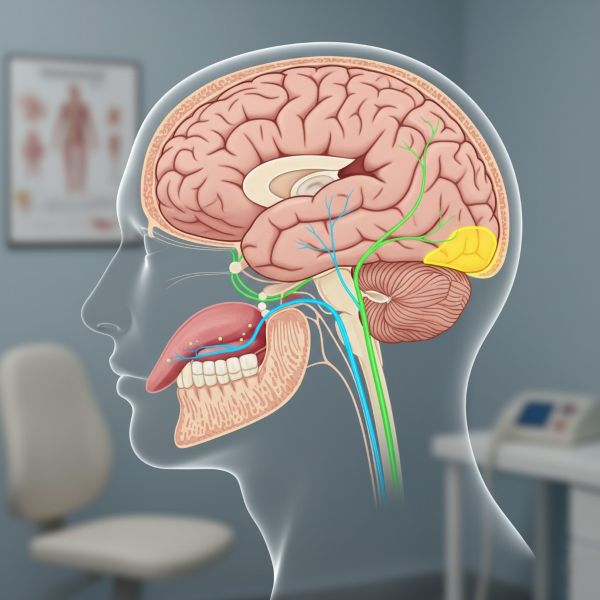Ageusia
Definition and Clinical Testing
Ageusia is the complete loss, and hypogeusia is the impairment, of the sense of taste (gustation). Clinically, this can be tested by applying the four fundamental tastes (sweet, sour, bitter, and salt) to each half of the protruded tongue to assess function.
Isolated ageusia is most commonly encountered as a transient feature associated with coryzal illnesses of the upper respiratory tract. Importantly, many complaints of loss of taste are in fact due to anosmia (loss of smell), since the olfactory sense is responsible for the discrimination of most flavors.

The sense of taste is transmitted via the facial (VII) and glossopharyngeal (IX) nerves to the brainstem, thalamus, and cortex.
Neural Pathway of Taste
Afferent taste fibers run in two cranial nerves: the facial (VII) nerve from taste buds in the anterior two-thirds of the tongue, and the glossopharyngeal (IX) nerve from the posterior one-third. These fibers travel to the brainstem and terminate in the nucleus of the solitary tract (the rostral part of which is called the gustatory nucleus). From there, fibers ascend to the ventral posterior nucleus of the thalamus and then project to the cortical area for taste in the insular region.
Causes and Clinical Significance
Neurological disorders can account for ageusia by damaging the taste pathway at various points:
- Facial (VII) Nerve Lesions: Lesions of the facial nerve proximal to where the chorda tympani branch departs (e.g., in Bell’s palsy) can cause ipsilateral loss of taste on the anterior two-thirds of the tongue. This is often accompanied by ipsilateral lower motor neuron facial weakness and sometimes hyperacusis.
- Glossopharyngeal (IX) Nerve Lesions: Damage to this nerve impairs taste on the posterior one-third of the tongue. It usually occurs with lesions affecting other lower cranial nerves (X, XI, XII), as seen in jugular foramen syndrome, leading to dysphonia, dysphagia, and a depressed gag reflex.
- Central Nervous System Lesions: Ageusia as an isolated neurological symptom is extremely rare but can result from focal lesions (infarct, tumor, demyelination) affecting the gustatory nucleus in the brainstem, the thalamus, or the insular cortex.
- Other Causes: Anosmia and dysgeusia (distorted taste) have also been reported following acute zinc loss.
References
Finelli PF, Mair RG. Disturbances of taste and smell. In: Bradley WG, Daroff RB, Fenichel GM, Marsden CD (eds.). Neurology in clinical practice (3rd edition). Boston: Butterworth Heinemann, 2000: 263-269
Hepburn AL, Lanham JG. Sudden-onset ageusia in the antiphospholipid syndrome. Journal of the Royal Society of Medicine 1998; 91: 640-641
Cross References
Anosmia; Bell’s palsy; Cacogeusia; Dysgeusia; Facial paresis; Hyperacusis; Jugular foramen syndrome

